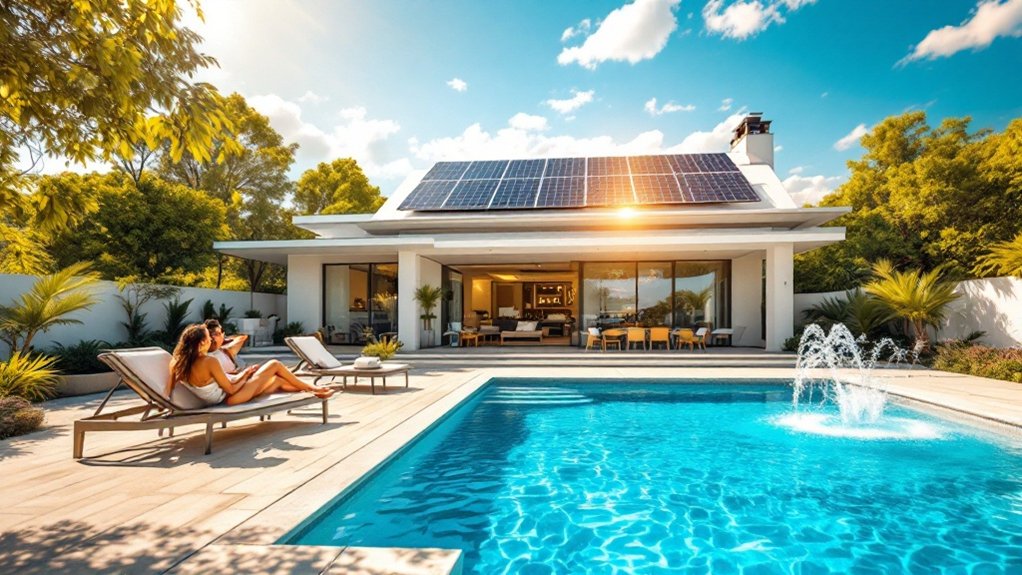The debate between solar-powered pool pumps and traditional electric pumps presents various considerations for pool owners. Each type has unique benefits and limitations that can influence performance, costs, and environmental impact. As homeowners weigh their options, factors such as sustainability, initial investment, and long-term expenses come into play. Understanding these aspects can help in making an informed decision. But which option ultimately proves to be the best fit for individual needs?
Overview of Pool Pump Types
Pool pumps play an essential role in maintaining the cleanliness and circulation of swimming pools. There are several types of pool pumps, each designed to cater to different needs and preferences. Traditional electric pool pumps are the most common, utilizing standard electrical power sources to operate efficiently. These pumps typically offer good performance but may incur higher energy costs over time. Another option is the variable-speed pumps, which can adjust their speed based on the pool’s requirements, leading to energy savings. Additionally, there are solar-powered pool pumps, which harness solar energy for operation, providing an eco-friendly alternative. Each type has its advantages and disadvantages, influencing a pool owner’s decision based on budget, energy efficiency, and environmental considerations.
How Solar-Powered Pool Pumps Work
Although solar-powered pool pumps might seem complex, they operate on a straightforward principle: harnessing sunlight to generate electricity. These systems are equipped with solar panels that convert solar energy into direct current (DC) electricity. This electricity powers the pump, allowing it to circulate water through the pool’s filtration system. The pumps typically include a solar inverter to convert DC electricity into alternating current (AC) if required by the pump’s motor. Solar-powered pool pumps can be designed to work independently or be integrated with existing pool systems. They often feature variable speed settings, enabling users to adjust the flow rate based on their pool’s specific needs. This efficient system guarantees effective water circulation while minimizing reliance on traditional energy sources.
Benefits of Solar-Powered Pool Pumps
While traditional pool pumps are effective, solar-powered alternatives offer numerous advantages that make them an appealing choice for pool owners. One significant benefit is the reduction in energy costs; solar pumps harness sunlight to operate, leading to substantial savings on electricity bills. Additionally, these pumps are environmentally friendly, contributing to a decrease in carbon footprint and promoting sustainable practices. Solar-powered pumps often require less maintenance due to fewer mechanical components, enhancing their longevity. Moreover, they operate quietly, ensuring a more pleasant poolside experience. Many models are designed for easy installation, allowing homeowners to enjoy the benefits without extensive renovations. Overall, solar-powered pool pumps present an efficient, cost-effective, and eco-conscious solution for maintaining a clean and inviting swimming pool.
Drawbacks of Solar-Powered Pool Pumps
Despite their many advantages, solar-powered pool pumps do have some drawbacks that potential buyers should consider. One significant concern is their reliance on sunlight, which can limit performance during cloudy days or in shaded areas. This inconsistency may result in inadequate pool filtration, especially in larger pools. Additionally, the initial installation cost can be higher compared to traditional pumps, which may deter some homeowners. Maintenance can also be more complex due to the solar panel system, requiring specialized knowledge. Moreover, solar-powered pumps typically have lower power output, which might not meet the demands of every pool size or type. Finally, the technology is still evolving, leading to potential concerns about long-term durability and replacement parts availability.
Understanding Traditional Electric Pool Pumps
Traditional electric pool pumps have been the standard choice for pool owners for many years, providing reliable and consistent performance. These pumps typically operate using a motor powered by electricity, which circulates water through the pool’s filtration system. Available in various horsepower ratings, they can accommodate different pool sizes and requirements. Traditional pumps are generally easy to install and integrate into existing pool systems. They require regular maintenance, including cleaning filters and checking for wear and tear. While they may not be the most energy-efficient option, their effectiveness in maintaining water clarity and hygiene makes them a popular choice. Pool owners often appreciate the familiarity and availability of replacement parts for traditional electric pumps.
Advantages of Traditional Electric Pumps
One key advantage of traditional electric pumps is their proven reliability, which appeals to many pool owners seeking a dependable solution for water circulation. These pumps are widely available and come in various sizes and power ratings, allowing users to select the ideal model for their specific pool needs. Traditional electric pumps typically operate with a consistent flow rate and are capable of handling larger volumes of water, ensuring efficient filtration and circulation. Additionally, their installation process is straightforward, often requiring minimal modifications to existing pool systems. The familiarity of traditional electric pumps also means that replacement parts are readily accessible and technicians are easily trained to service them, providing peace of mind for pool owners concerned about maintenance and repairs. Furthermore, proper maintenance of pool equipment is crucial for keeping these pumps functioning optimally over time.
Disadvantages of Traditional Electric Pumps
Traditional electric pool pumps present significant disadvantages, primarily due to their high energy costs. These expenses can accumulate over time, making them less economical for long-term use. Additionally, their reliance on conventional electricity sources contributes to a larger environmental impact, raising concerns about sustainability.
High Energy Costs
High energy costs present a significant disadvantage for electric pool pumps, impacting both homeowners’ budgets and environmental sustainability. Traditional electric pumps require a continuous energy supply to operate, which can lead to substantial monthly utility bills, especially during peak swimming seasons. This ongoing expense can deter some homeowners from maintaining their pools, potentially reducing property value and enjoyment. Additionally, the reliance on grid electricity exposes users to fluctuating energy prices, making budgeting challenging. Over time, these costs can accumulate, leading to financial strain. As energy demands rise, homeowners may find it increasingly difficult to justify the long-term investment in traditional electric pumps, prompting a search for more cost-effective and sustainable alternatives.
Environmental Impact
The reliance on traditional electric pool pumps not only burdens homeowners with high energy costs but also raises considerable environmental concerns. These pumps typically consume a substantial amount of electricity, contributing to increased carbon emissions from fossil fuel power plants. The manufacturing process of electric pumps also generates waste and pollution, further harming ecosystems. Additionally, traditional pumps often use materials that are not environmentally friendly and may not be recyclable. Their constant operation can lead to higher water usage and energy depletion, exacerbating the strain on local resources. In contrast, solar-powered pumps present a greener alternative, utilizing renewable energy and minimizing the ecological footprint associated with pool maintenance. Shifting to solar options can markedly reduce environmental impact.
Cost Comparison: Solar vs. Traditional
The cost comparison between solar-powered pool pumps and traditional electric pumps involves several critical factors. Initial investment costs can vary considerably, with solar options often requiring a higher upfront expenditure. However, the long-term savings potential and maintenance expenses can make solar pumps a more economical choice over time.
Initial Investment Costs
Investing in a pool pump requires careful consideration of both initial costs and long-term savings. Solar-powered pool pumps typically have a higher upfront investment compared to traditional electric models. The average cost of a solar pump system can range from $1,500 to $3,500, depending on the size and specifications. In contrast, traditional pumps generally cost between $500 and $1,500. While the initial expense for solar pumps is steep, they often come with additional components, such as solar panels and inverters, which contribute to the higher price. Homeowners must weigh these initial financial commitments against their budget and future energy savings. Ultimately, the decision hinges on how much value is placed on sustainability and energy independence in the pool maintenance process.
Long-Term Savings Potential
Often, homeowners find that solar-powered pool pumps offer significant long-term savings compared to traditional electric models. The primary cost advantage stems from reduced electricity expenses, as solar pumps harness energy from the sun, leading to minimal operational costs. Over time, these savings can accumulate, offsetting the initial investment and delivering a favorable return. Additionally, solar-powered pumps typically have fewer moving parts and are designed for durability, which can contribute to lower replacement and repair costs over their lifespan. While traditional pumps may seem less expensive upfront, their ongoing energy consumption can result in higher utility bills, diminishing overall savings. To summarize, solar-powered pool pumps present a compelling financial case for those seeking long-term efficiency and cost-effectiveness.
Maintenance Expenses Comparison
While traditional pool pumps require regular maintenance that can lead to escalating costs, solar-powered pumps generally demand less upkeep. Traditional pumps often necessitate frequent inspections, filter cleaning, and occasional repairs, which can accumulate significant expenses over time. In contrast, solar-powered pumps, benefiting from fewer moving parts and reliance on renewable energy, typically need less frequent maintenance. This reduced need for upkeep translates to lower ongoing costs for homeowners. Additionally, many solar pumps come with warranties that cover parts and labor for extended periods, further decreasing potential financial burdens. Consequently, when evaluating maintenance expenses, solar-powered pool pumps present a more economical choice in the long run, offering both environmental benefits and reduced financial commitments for pool owners.
Making the Right Choice for Your Pool
When deciding between solar-powered pool pumps and traditional models, homeowners must consider various factors that impact efficiency, maintenance, and cost. Solar-powered pumps offer the advantage of reduced energy bills and environmental benefits, utilizing renewable energy to operate. However, initial installation costs can be higher, and performance may vary based on sunlight availability. Traditional pumps, while generally lower in upfront costs, typically incur higher long-term energy expenses and maintenance needs. Homeowners should also evaluate their pool size, usage patterns, and local climate. Ultimately, the right choice hinges on individual priorities, such as eco-friendliness, budget constraints, and desired operational efficiency. By weighing these factors carefully, homeowners can make an informed decision that best suits their unique pool requirements.
Frequently Asked Questions
How Long Do Solar-Powered Pool Pumps Typically Last?
The longevity of solar-powered pool pumps generally ranges from 10 to 20 years, depending on factors such as maintenance, usage, and environmental conditions. Regular upkeep can greatly enhance their lifespan and operational efficiency.
Can Solar-Powered Pumps Operate During Cloudy Weather?
The ability of solar-powered pumps to operate during cloudy weather depends on sunlight availability. While efficiency decreases, they can still function, albeit less effectively, relying on diffused light to generate sufficient energy for operation.
Are Solar Pumps Compatible With All Pool Types?
The compatibility of pumps with various pool types depends on their specific design and installation requirements. Generally, solar pumps can be adapted for most pools, but consulting a professional guarantees ideal performance and suitability for each unique setup.
What Maintenance Do Solar-Powered Pumps Require?
Maintenance for solar-powered pumps typically includes regular cleaning of solar panels, checking for debris in the system, ensuring proper water flow, and monitoring connections for corrosion, which helps maintain efficiency and prolongs the pump’s lifespan.
How Do I Size a Solar Pool Pump Correctly?
Sizing a pool pump correctly involves considering the pool’s volume, desired turnover rate, and specific flow requirements. Proper calculations guarantee efficient circulation, optimizing water quality and energy consumption, regardless of the pump type employed.
Conclusion
To summarize, the choice between solar-powered pool pumps and traditional electric pumps hinges on individual preferences and circumstances. Solar-powered options offer eco-friendly benefits and lower operational costs, particularly for those prioritizing sustainability. However, they may encounter performance challenges in less sunny conditions. Conversely, traditional electric pumps guarantee reliable functionality and straightforward maintenance, albeit at a higher long-term energy expense. Ultimately, prospective buyers should weigh their budget, environmental values, and specific pool needs before making a decision.




